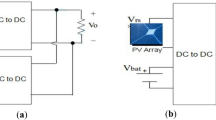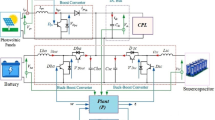Abstract
This paper presents a comprehensive transient and steady-state analysis of hybrid powered DC series motor through DC shunt and PV generators. The solar cell generator is interfaced with the system through a DC–DC buck–boost switch mode converter. At full solar irradiance, the PV generator can completely run the DC series motor as its maximum power point is placed at the rated conditions of the DC series motor. As the solar intensity decreases, the shortage of power demanded by the series motor is compensated by the fuel-driven DC generator. To fully utilize the pollution-free PV generator at various solar intensities and, therefore, to reduce the total fuel consumption by the prime mover of the DC shunt generator, the operating point of the solar cells in case of hybridization is adjusted at its maximum power point by automatically calibrating the terminal voltage at the common coupling point of the two generators. The transient analysis comprises step changes in the load coupled to the motor at different solar irradiances and after successive step changes on the solar illuminations for some given fixed loading conditions. The nonlinearities of the PV generator are taken into account along with that of the ferromagnetic material of the two DC machines. The effect of changing the field resistance of the DC generator on the performance of the system is addressed. The steady-state output characteristics of the DC series motor when powered by only PV generator at full solar illumination, in case of hybridization at 0.85 and 0.70 of full solar intensity are outlined and compared.










Similar content being viewed by others
References
Widyan MS (2010) Dynamical and steady-state characteristics of DC motors powered by photovoltaic systems via DC–DC Buck–Boost switch mode converter. Int J Power Energy Syst 30(2):148–156
Widyan MS, Al-Tarabsheh AI, Etier IY, Hanitsch RE (2010) Dynamic and steady-state analysis of DC machines fed by photovoltaic systems. Int J Model Simul 30(3):353–360
Metwally HM, Anis WR (2006) Dynamic performance of directly coupled PV pumping system. Energy Convers Manag 37(9):1407–1416
Kusiak A, Zhang Z, Li M (2010) Optimization of wind turbine performance with date driven models. IEEE Trans Sustain Energy 1(2):66–76
Hanitsch RE, Widyan MS (2005) Design, construction and test of a permanent-magnet prototype machine for wind energy applications. In: 8th International Conference on Electrical Machines and Systems (ICEMS’05), 27–29 September, Nanjing, China
Estanqueiro AI (2007) A dynamic wind generator model for power systems studies. IEEE Trans Power Syst 22(3):920–928
Karrari M, Rosehart W, Malik OP (2005) Comprehensive control strategy for a variable speed cage machine generation unit. IEEE Trans Energy Convers 20(2):415–423
Schulz D, Hanitsch R (2003) Grid interaction and power quality parameters of grid coupled photovoltaic systems and wind energy converters. Power and Energy Systems. Palm Springer, CA, pp 24–26
Kjaer SB, Pedersen JK, Blaabjerg F (2005) A review of single grid-connected inverters for photovoltaic modules. IEEE Trans Ind Appl 41(5):1292–1306
Skretas SB, Papadopoulos DP (2009) Efficient design and simulation of an expandable hybrid (Wind-Photovoltaic) power system with MPPT and inverter input voltage regulation features in compliance with electric grid requirements. Electric Power Syst Res 79:1271–1285
Anagreh Y (2001) Steady state performance of series DC motor powered by wind driven self-excited induction generator. Rev Energy Power Eng 9–15
Ahmed NA, Miyatake M, Al-Othman AK (2008) Power fluctuations suppression of stand-alone hybrid generation combining solar photovoltaic/wind turbine and fuel cell systems. Energy Convers Manag 49:2711–2719
Zhou W, Lou C, Li Z, Yang H (2010) Current status on optimum sizing of stand-alone hybrid solar-wind power generation systems. Appl Energy 87:380–389
Zhang X, Chau KT (2011) An automotive thermoelectric-photovoltaic hybrid energy system using maximum power point tracking. Energy Convers Manag 52:641–647
Sreeraj ES, Chatterjee K, Bandyopadhyay S (2010) Design of isolated renewable hybrid power systems. Solar Energy 84:1124–1136
Chiang HC, Ma TT, Cheng YH, Chang JM, ChaNG WN (2010) Design and implementation of hybrid regenerative power system combining grid-tie and uninterruptible power supply functions. IET Renew Power Gener 4(1):85–99
Nehrir MH, Wang C, Strunz K, Aki H, Ramakumar R, Bing J, Miao Z, Salameh Z (2011) A review of hybrid renewable/alternative energy systems for electric power generation: configurations, control and applications. IEEE Trans Sustain Energy 2(4):392–403
Salas V, Olis E, Barrado A, Lazaro A (2006) Review of the maximum power point tracking algorithms for stand-alone photovoltaic systems. Solar Energy Mater Solar Cells 90:1555–1578
Author information
Authors and Affiliations
Corresponding author
Appendices
Appendix A
The following are the physical explanations of system mathematical model parameters:
- \(L_\mathrm{m} \) :
-
DC series motor armature and field circuits self inductances
- \(i_\mathrm{PV}\) :
-
PV generator output current
- \(V_\mathrm{PV}\) :
-
PV generator terminal voltage
- \(R_\mathrm{m}\) :
-
DC series motor armature and field circuits resistances
- \(K_\mathrm{m}\) :
-
DC series motor design constant
- \(\phi _\mathrm{m}\) :
-
DC series motor flux
- \(\omega _\mathrm{m}\) :
-
DC series motor rotational speed
- \(J_\mathrm{m} \) :
-
DC series motor and load moment of inertia
- \(T_\mathrm{L} \) :
-
Mechanical load coupled to the motor
- \(\beta _1 , \beta _2 \) and \(\beta _3 \) :
-
Polynomial constants representing the magnetizing curve of the DC series motor
- \(L_\mathrm{g}\) :
-
DC shunt generator armature circuit self inductance
- \(i_\mathrm{g} \) :
-
DC shunt generator armature current
- \(R_\mathrm{g} \) :
-
DC shunt generator armature circuit resistance
- \(\omega _\mathrm{g} \) :
-
DC shunt generator rotational speed
- \(L_\mathrm{f} \) :
-
DC shunt generator field circuit self inductance
- \(i_\mathrm{f} \) :
-
DC shunt generator field circuit current
- \(R_\mathrm{f} \) :
-
DC shunt generator field circuit resistance
- \(R_\mathrm{adj} \) :
-
DC shunt generator field circuit adjustable resistance
- \(J_\mathrm{g} \) :
-
DC shunt generator and prime mover moment of inertia
- \(\alpha _1 , \alpha _2\) and \(\alpha _3 \) :
-
Polynomial constants representing the magnetizing curve of the DC shunt generator
- \(T_\mathrm{V} \) :
-
Time constant of the voltage controller
- \(T_\mathrm{m} \) :
-
Mechanical torque output from the prime mover
- \(V_\mathrm{ref} \) :
-
Reference voltage of the voltage controller
- \(V_\mathrm{g} \) :
-
Terminal voltage of the DC shunt generator
- \(K_\mathrm{V} \) :
-
Gain of the voltage controller
Appendix B
The following are the values of the constants of the system mathematical model:
\(L_\mathrm{m} =62\,\hbox {mH},\,R_\mathrm{m} =0.44\,\Omega ,\,J_\mathrm{m} =0.5\,\hbox {kg m}^{2},\,\beta _1 =-0.0017\, \mathrm{Wb/A}^{2},\,\beta _2 =0.0938\,\hbox {Wb/A},\,\beta _3 =0.0062\,\hbox {Wb}, L_\mathrm{g} =18\,\hbox {mH}, R_\mathrm{g} =0.24\,\Omega ,\,\alpha _1 =-0.3084\,\hbox {Wb/A}^{2},\,\alpha _2 =1.0272\, \hbox {Wb/A},\,\alpha _3 =0.0049\,\hbox {Wb},\,L_\mathrm{f} =10\,\hbox {H},\,R_\mathrm{f} +R_\mathrm{adj} =100\,\Omega , J_\mathrm{g} =0.5\,\hbox {kg m}^{2},\,T_\mathrm{V} =0.5\,\hbox {s}, V_\mathrm{ref} =130\,V,\,K_\mathrm{V} =10\,\mathrm{Nm/V}\).
Appendix C
The values of the 10th order polynomial curve of the output characteristics of the PV generator at the three solar intensities are:
Constant | Full solar illumination | 0.85 of full solar illumination | 0.70 of full solar illumination |
|---|---|---|---|
\(\gamma _1 \quad (\mathrm{V/A}^{10})\) | -0.0000001946676 | -0.0000009393512 | -0.0000060645127 |
\(\gamma _2 \quad (\mathrm{V/A}^{9})\) | 0.0000173750718 | 0.0000712655896 | 0.0003789020201 |
\(\gamma _3 \quad (\mathrm{V/A}^{8})\) | -0.0006612144493 | -0.0023052314457 | -0.0100934744372 |
\(\gamma _4 \quad (\mathrm{V/A}^{7})\) | 0.0139854557681 | 0.0414445806261 | 0.1494421186619 |
\(\gamma _5 \quad (\mathrm{V/A}^{6})\) | -0.1796699014675 | -0.4525696026617 | -1.3439086881053 |
\(\gamma _6 \quad (\mathrm{V/A}^{5})\) | 1.4387276827434 | 3.0804032776748 | 7.5330538490437 |
\(\gamma _7 \quad (\mathrm{V/A}^{4})\) | -7.0882339219053 | -12.8998881292824 | -25.9793663015432 |
\(\gamma _8 \quad (\mathrm{V/A}^{3})\) | 20.4035579282125 | 31.5625972539290 | 52.3473206103495 |
\(\gamma _9 \quad (\mathrm{V/A}^{2})\) | -30.7877840811318 | -40.4822074593410 | -55.2923468949142 |
\(\gamma _{10} \quad (\mathrm{V/A})\) | 17.5214040234632 | 19.5827456844042 | 22.0269079020039 |
\(\gamma _{11} \quad (\mathrm{V})\) | 172.9875813716187 | 164.3382023014351 | 152.2290716084487 |
Rights and permissions
About this article
Cite this article
Widyan, M.S., Harb, A.M. & Al-Oquili, O.M. Transient and steady-state performance analysis of hybrid powered DC series motor via DC shunt and PV generators with maximum power point tracking. Electr Eng 96, 99–107 (2014). https://doi.org/10.1007/s00202-013-0282-x
Received:
Accepted:
Published:
Issue Date:
DOI: https://doi.org/10.1007/s00202-013-0282-x




